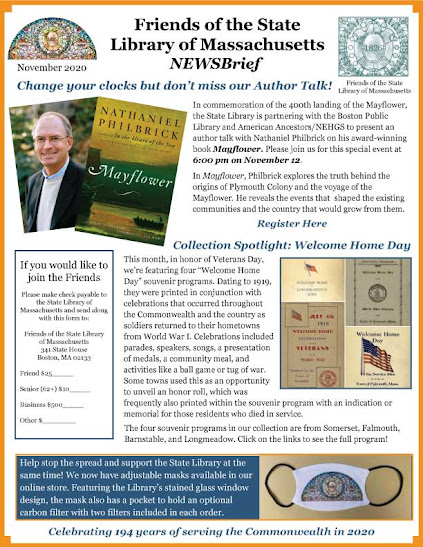As Thanksgiving ends and we look towards the upcoming holiday season, it’s time to pick a new item for our virtual display! This December, we’re sharing Christmas Eve on Beacon Hill, a small twenty page booklet from our collection that dates to 1918.
Christmas Eve on Beacon Hill was written by Richard Bowland Kimball, a resident of the neighborhood, with drawings done by Maurice Day. Kimball, who was a new arrival to Beacon Hill, writes that he was unaware of Beacon Hill’s Christmas Eve celebrations when he first accepted an invitation from a friend to participate. He describes walking around the neighborhood and seeing “candles beyond counting in the windows. Delia Robbia Madonnas or painted medieval ecclesiastical carvings fastened to the old housewalls, green wreaths on the old white doors, Christmas trees behind the panes; and moving among the groups, church choirs, led by trumpeters, stopping and singing before the houses old carols.” Kimball was experiencing a popular Beacon Hill tradition that had begun almost a decade prior.
Beacon Hill decorated with candles in the windows and carolers on the streets can be attributed to Elizabeth Cram, wife of architect Ralph Adams Cram. Circa 1907, Elizabeth urged her friends to place candles in their windows on Christmas Eve, and after being well received, the group formed the Chestnut Street Christmas Association. The association began formally organizing Christmas Eve candle and caroling festivities, and it proved to be so popular that people came from around the city to visit Beacon Hill. In the coming years, the tradition of lighting candles even spread elsewhere in the city as well as to cities far and wide. As Kimball writes in 1918, “Last year Christmas Eve was celebrated with candles and carols as far west as San Francisco, as far north as Labrador.” As a fun Christmas addition, you can also click here to see a Cram family Christmas card designed by Ralph Adams Cram and held in Historic New England’s ephemera collection.
As the preservation librarian, I should also note that this booklet could use a little repair work! Based on the digitized images, it looks like there is a fair amount of non-archival adhesive tape that was used for mending over the years. In the lab, we would try to remove that tape, mend the pages, and perhaps re-do the simple pamphlet stitch that was done as the binding. Some general cleaning would give it a nice fresh look, too! Though we’re not in the lab at the moment, I can flag this item for preservation attention once we’re back on-site, and maybe it will look good as new by the time the holiday season rolls around in 2021!
We are featuring the cover of this booklet here on the blog, with its ornate font and a beautiful night time illustration looking up Chestnut Street to the golden dome of the State House. The image is flanked by taper candles, similar to the ones that would have been found in the windows of Beacon Hill homes. To see the full booklet, be sure to check it out on DSpace. Take a close look at all of the festive drawings of Beacon Hill windows adorned with wreaths and candles. And regardless of how or if you celebrate the holiday season, we wish everyone a happy and healthy December full of good cheer.
Elizabeth Roscio
Preservation Librarian










